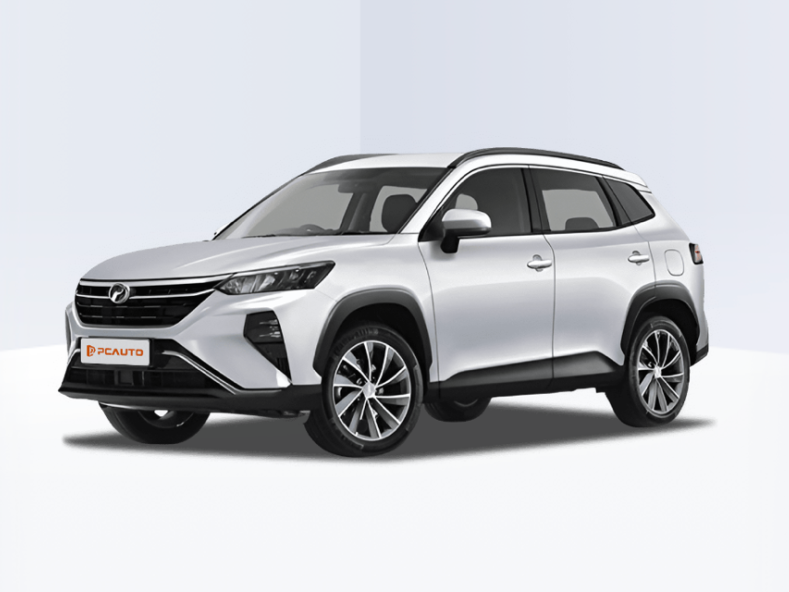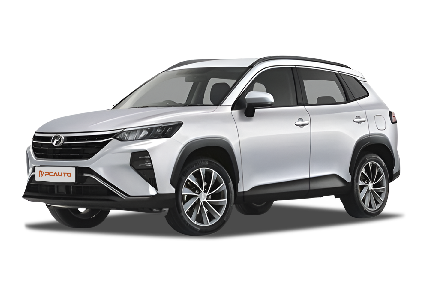Q
What are the safety features of the Perodua Nexis?
According to Perodua's official service manual for the Axia, the main engine oil change interval for this model is typically every 10,000 kilometers or 6 months, whichever comes first. This guideline is tailored to Malaysia's common driving conditions and climate. If your Axia spends a lot of time operating under severe conditions—think constant high temperatures, dusty environments, or lots of short trips—you'll want to bump that up to every 5,000 kilometers to keep that engine properly lubricated.
It's crucial to use Perodua-approved oil, like SAE 5W-30 or 10W-30 viscosity grades, to maximize engine longevity. And don't sleep on regular checks: keeping an eye on both oil level and condition is a key part of day-to-day maintenance. For Malaysian owners, beyond sticking to the official schedule, there are telltale signs to watch for. If the oil turns really dark or feels less viscous, or if you notice unusual engine noises, it might be time for an early change. Whatever you do, don't stretch the oil change interval too far—you could end up compromising engine performance.
It's worth noting that similar models in this segment, like the Proton Saga, follow comparable service intervals. At the end of the day, developing a habit of regular maintenance is the best way to keep your ride running in top shape.
Special Disclaimer: This content is published by users and does not represent the views or position of PCauto.
Related Q&A
Q
Which Segment Does Perodua Nexis Belong to?
The Perodua Nexis falls into the B-Segment SUV category. This vehicle is positioned slightly higher than the Axia and Bezza in Perodua's product line. It mainly targets young family users who pursue space practicality and stylish design. The body size of the Perodua Nexis is expected to be similar to that of the Proton X50, but its price will be more affordable, continuing Perodua's characteristic of high cost - effectiveness.
B - Segment SUVs are very popular in the Malaysian market. Vehicles in this category usually have a relatively high ground clearance and flexible cabin space, which are suitable for the diverse local driving environments, including urban commuting and occasional countryside trips.
The Perodua Nexis is expected to be equipped with an energy - efficient 1.5L Dual VVT - i engine and may come with advanced safety systems such as ASA 3.0, continuing the brand's tradition of emphasizing fuel economy and safety.
For Malaysian consumers, B - Segment SUVs are a popular choice that combines practicality and a sense of trend. With its mature local production and a well - established after - sales service network, Perodua can often provide solutions that better meet local needs.hts.
Q
How much engine displacement of Perodua Nexis?
The Perodua Nexis has not been officially launched yet, so the official has not announced its specific engine displacement (CC) data. However, according to industry speculation, this upcoming B-segment SUV might be equipped with the same 1.0-liter three-cylinder turbocharged engine as the Perodua Ativa. The engine has a displacement of 998cc, a maximum power of 98 horsepower, and a peak torque of 140 N·m, and is paired with a D-CVT gearbox. If the final configuration turns out to be true, this small-displacement turbocharged engine can balance fuel economy and power performance, making it very suitable for the urban road conditions in Malaysia. Meanwhile, Perodua models generally adopt a lightweight design, which further optimizes fuel consumption. It is recommended that consumers keep an eye on the latest news from the official Perodua website or authorized dealers to get accurate information. When making a purchase, Malaysian car owners can also make a horizontal comparison with engines of similar models, such as the 1.5TGDI engine (1477cc) of the Proton X50 or the 1.5L naturally aspirated engine (1498cc) of the Honda HR-V. However, they need to pay attention to the differences in road tax, insurance, and maintenance costs among engines with different displacements.
Q
What Engine is used in Perodua Nexis?
The Perodua Nexis is expected to be equipped with a 1.5-liter Dual VVT-i naturally aspirated engine. This engine shares the technical platform with models like the Perodua Ativa and Toyota Rush. It has a maximum output power of about 106 horsepower and a peak torque of 138 Nm. It is paired with a D-CVT transmission, focusing on fuel economy and smoothness in daily driving. The engine adopts a dual variable valve timing system, which can optimize the intake and exhaust efficiency at both low and high speeds and meets the EURO 4 emission standards in the Malaysian market. For Malaysian users who value practicality, this kind of small-displacement engine can balance the fuel consumption during city commuting and the occasional long-distance needs, and the maintenance cost is relatively low. It's worth mentioning that Perodua has gradually upgraded its power technology in recent years. For example, a more efficient 1.0-liter turbocharged option has been applied to models like the Bezza. In the future, it may also offer a hybrid version for the Nexis to adapt to the market trend, but the specific details shall be subject to the official release. The engine design of this kind of compact SUV usually gives priority to durability in tropical climates. It is recommended that car owners conduct regular maintenance to ensure long-term performance.
Q
What is the Gearbox Type of Perodua Nexis?
As an upcoming all-new SUV model, the official details about the transmission type of the Perodua Nexis haven't been released yet. However, based on Perodua's consistent technical approach and market positioning, it's expected to be equipped with a proven D-CVT continuously variable transmission or a 4-speed automatic transmission. These two types of transmissions have been widely used in Perodua's existing models like the Aruz and Bezza. They are particularly suitable for the urban road conditions in Malaysia, balancing fuel economy and a smooth driving experience.
It's worth noting that the D-CVT transmission offers a more direct power response by simulating gear shifts, while the traditional automatic transmission is known for its durability and low maintenance costs. Consumers can choose according to their own driving habits. If the Nexis is positioned as a youthful SUV, more advanced transmission technologies may be introduced to enhance its competitiveness. It is recommended to follow Perodua's official press conference for the final configuration information.
Malaysian consumers can refer to the actual test - drive experience when making a purchase. The transmission tuning has a significant impact on the daily driving comfort. Meanwhile, the transmissions of all Perodua models have been locally adapted to suit the tropical climate and diverse road conditions.
Q
Does Perodua Nexis Support Apple Carplay?
As a newly launched model, it hasn't been officially confirmed whether the Perodua Nexis is equipped with Apple CarPlay. It is recommended that interested consumers directly contact Perodua dealers or check the official website for the latest configuration information. Apple CarPlay is a very practical in - vehicle connectivity technology. It allows iPhone users to directly use common functions such as navigation, music, and calls through the car's infotainment screen, enhancing driving convenience and safety. In the Malaysian market, more and more new cars are starting to be equipped with this feature, especially models from Japanese and local brands. If the Nexis gets this configuration in the future, its market competitiveness will be greatly enhanced. Apart from Apple CarPlay, Android Auto is also a similar in-vehicle connectivity system, which enables Android phone users to achieve the same convenient operations. For Malaysian consumers who value the technological experience, they can pay more attention to these smart connectivity configurations when buying a new car, as they can significantly improve the daily driving experience.
Q
What is the Tyre Brand of Perodua Nexis?
As the only part of the vehicle that contacts the ground, tires are crucial for driving safety, fuel consumption performance, and noise control. It is recommended that car owners give priority to products that match the original factory specifications (such as size 195/55 R16 or similar parameters) when replacing tires in the future. Also, pay attention to the tread wear indicator lines to ensure safety. If you're after better performance, you can consider upgrading to silent or energy-saving tires after the warranty period. But be aware that modifications may affect the original factory warranty terms, so it's advisable to consult an authorized service center.
In Malaysia's rainy climate, it's particularly important to choose tire treads with strong wet-grip performance. Regularly checking tire pressure and the aging condition of the tires is also basic maintenance knowledge.
Q
Is Perodua Nexis a Good Car? Learn the Pros and Cons Here
As an upcoming all-new SUV model, the currently official information reveals that the Perodua Nexis is positioned as a B-segment urban SUV. It is expected to be powered by a combination of a 1.5L Dual VVT-i engine and a D-CVT gearbox. This market-proven powertrain has advantages in terms of fuel economy and maintenance costs, making it particularly suitable for the urban road conditions in Malaysia and consumers' demand for practicality. Judging from the released teaser images, the Nexis adopts Perodua's latest family design language. The body lines are more sporty. The interior is expected to continue the brand's layout style that emphasizes functionality and may be equipped with an advanced ASA active safety system, which is quite attractive to Malaysian family users who value safety. Although the specific configuration and price have not been announced yet, referring to Perodua's consistent market strategy, the Nexis is likely to follow the high-cost-performance route, competing differently with the Proton X50 and providing consumers with a more affordable SUV option. It is recommended that potential buyers pay attention to the upcoming detailed specifications and take a test drive to experience its space performance and handling feel. At the same time, compare the after-sales warranty policies of models in the same class. After all, a 5-year warranty period has become the mainstream standard in the Malaysian market, and Perodua's nationwide service center network is a remarkable advantage for its after-sales service.
Q
What is the Second Hand Price of Perodua Nexis? Check Used Price Here
Normally, used - car prices are affected by multiple factors such as the vehicle's age, mileage, condition, maintenance records, and market demand. Take other popular Perodua models like the Myvi or Axia as an example. The used - car prices of vehicles with a 1 - 3 - year age are approximately 60% - 80% of the original price, but the specific price depends on the configuration and market supply and demand.
If you're considering buying a used car, it is advisable to check vehicles that have undergone professional inspections through authorized dealers or certified platforms. At the same time, pay attention to checking the Service Book to confirm the maintenance history, and it is recommended to take a test drive to confirm the mechanical condition.
For models about to be launched, you can also refer to the depreciation curves of similar - positioned models of the same brand as a future reference. However, note that the application of new technologies or differences in configurations may cause price fluctuations.
Q
What is the Fuel Consumption of Perodua Nexis?
As an upcoming all-new SUV model, the official fuel consumption data of the Perodua Nexis has not been officially released yet. But referring to Perodua's consistent use of energy-saving technologies such as the DVVT dual variable valve timing system and lightweight body design, it is expected that its fuel economy will continue the brand's advantage, possibly ranging from 5.0 to 6.5 liters per 100 kilometers. The specific performance depends on the actual power configuration (such as a 1.5L naturally aspirated engine or a hybrid system) and driving conditions.
For Malaysian consumers, in the daily use scenarios of urban commuting combined with highway sections, this kind of compact SUV can usually balance power and fuel consumption. It is recommended to pay attention to the actual test data released by the subsequent PUSPAKOM certification or the Energy Efficiency Label (EEV).
It is worth mentioning that fuel consumption is significantly affected by driving habits, road conditions, and maintenance status. Regularly maintaining tire pressure and avoiding rapid acceleration and deceleration can improve fuel efficiency. And the reasonable use of air conditioning in Malaysia's hot climate is also a key factor in optimizing energy consumption.
If you have higher requirements for energy efficiency, you can compare it with models in the same class, such as the 1.5TGDI engine of the Proton X50, or wait for the technical details of Perodua's potential hybrid version.
Q
Is Perodua Nexis Worth Buying? Check out Its Features Here!
The Perodua Nexis, as an upcoming all-new SUV model, is truly worth the attention of Malaysian consumers. It is expected to be equipped with a 1.5L Dual VVT-i engine, paired with a D-CVT transmission, offering a smooth driving experience and good fuel economy, which is suitable for daily commuting and family use. Based on the known information, the Nexis might be equipped with advanced safety systems such as ASA 3.0 (Advanced Safety Assist) and six airbags, which are quite competitive among models in the same class. The interior space is expected to continue Perodua's consistent practicality. The rear seats can be folded down to increase the luggage capacity, meeting the multi - purpose needs of Malaysian families. Although the official has not yet announced the full configuration and price, referring to Perodua's high - cost - performance strategy for previous models like the Ativa and Aruz, the Nexis is very likely to continue this advantage. For consumers with a budget of around 100,000 ringgit who are looking for reliability and practicality, they might as well wait for more official information before making a decision. Given Malaysia's rainy and hot climate, it is recommended that consumers pay extra attention to the vehicle's air - conditioning cooling effect and anti - rust process when buying a car. These details can often enhance the long - term driving experience.
Popular Cars
Model Year
Car Compare
Car Photo
Latest Q&A
Q
Can a car have 1000 hp?
Absolutely. There are already multiple production or heavily modified cars on the market that can hit—or even surpass—1,000 horsepower. These are typically high-performance supercars or extensively tuned race machines. Think hybrid hypercars where the combined output easily breaks the four-digit barrier, or enthusiast-built monsters with forged internals, turbocharging, or supercharging that push ordinary cars into this territory.
But here’s the catch: power at this level demands next-level cooling, drivetrain robustness, and chassis tuning. Daily driving? Expect steep maintenance costs and thirstier fuel bills. For most enthusiasts, a 600-horsepower performance car already delivers thrills to spare—1,000 hp is more about bragging rights or track dominance.
One last thing: if you’re buying or building a car like this, double-check local regulations. Emissions and noise rules can turn your dream machine into a garage queen if you’re not careful.
Q
What is the highest HP ever?
The current production car horsepower record holder is the Bugatti Chiron Super Sport 300+, with its monstrous 8.0-liter W16 quad-turbo engine pumping out 1,600 horsepower and a top speed of 490 km/h – though these hypercars usually require race fuel and track conditions to unlock their full potential.
Venturing into the modified car realm, beasts like Top Fuel Dragsters with their supercharged V8s can unleash over 11,000 horsepower, but only in brutal 3-4 second bursts. That said, raw horsepower figures don’t tell the whole story. Torque delivery, weight distribution, and drivetrain efficiency are equally critical – just look at how EVs embarrass high-performance ICE cars off the line thanks to instant torque.
For real-world driving, 300-500 horsepower in a performance car delivers more than enough thrills, while something like an F1 car’s 1,000-horsepower hybrid powertrain represents the cutting edge of energy management.
Q
Can a car have 800 horsepower?
Sure thing. Right now, there are quite a few high-performance cars on the market pushing 800 horsepower or even more. These beasts usually fall into the supercar or heavily modified performance car category—think flagship models from top-tier brands or professionally tuned builds. They achieve that insane power through massive engines, turbocharging, or hybrid systems.
An 800-horsepower car is brutally quick, often hitting 0-100 km/h in under 3 seconds, but it also demands serious skill to handle, not to mention upgraded cooling and braking systems. Keep in mind, though, that this much power isn’t exactly practical for daily driving—it’s more at home on a track or special occasions. Local factors like fuel quality, road conditions, and legal restrictions also come into play.
If you’re into high-performance machines, follow expert auto media or test-drive events to experience them firsthand. Just remember to pick a car that actually suits your needs—not just the numbers on paper.
Q
Can a car have 900 horsepower?
Absolutely! A car with 900 horsepower isn’t just possible—it’s already a reality. There are plenty of high-performance models and even tuned vehicles hitting that mark, like certain top-tier supercars or professionally modified race cars. They achieve this insane power output through turbocharged big-block engines, hybrid systems, or pure electric drivetrains.
But let’s be real—this kind of horsepower usually requires reinforced transmissions, cooling systems, and chassis to handle the stress and keep things safe and stable. For daily driving, most cars sit comfortably in the 100–300 hp range, which is more than enough. Ultra-high-horsepower beasts are built for extreme performance or track dominance, and they come with eye-watering price tags and maintenance costs. Unless you’re a hardcore enthusiast or a professional driver, chasing that much power is overkill. At the end of the day, on public roads, keeping speeds sensible and following traffic rules is what really matters.
Q
Is 100 horsepower a lot?
100 horsepower is sufficient for daily driving to handle most road conditions, especially during urban commuting or short trips. Some small cars or entry-level family cars are usually within this power range, providing good fuel economy and basic acceleration performance. However, if you often need to overtake at high speeds, climb slopes, or carry heavy loads, you may feel that the power is slightly insufficient. At this time, higher horsepower models are more suitable. Horsepower is not the only criterion for measuring the quality of a car. Factors such as torque, weight, and gearbox matching also need to be considered. For example, some diesel cars may not have high horsepower but have ample torque, making them more suitable for carrying heavy loads or long-distance driving. Electric cars, on the other hand, due to their instantaneous torque output characteristics, can provide agile acceleration even if the horsepower data is not high. When choosing a vehicle, it should be determined based on its actual use. If it is mainly for urban commuting, 100 horsepower is completely sufficient. If you pursue driving pleasure or frequently travel long distances, you can consider higher power models.
View MoreRelated News

Perodua Nexis / Traz (D66B) how much will it sell for?
RobertDec 17, 2025

Perodua D66B teaser revealed, a new B-segment SUV based on the Yaris Cross is coming soon
WilliamDec 10, 2025

Should I choose Proton X50, or continue waiting for the repeatedly disappointing Perodua Nexis?
JohnNov 22, 2024

Will Perodua Nexis (D66B) Compete with Proton X50?
LienJun 19, 2024

Perodua Traz VS Ativa, which one is more worth buying?
AshleyDec 23, 2025
View More

















Pros
Cons